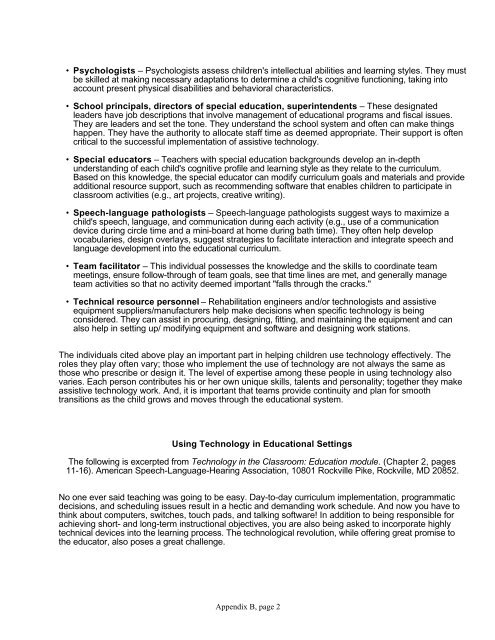Oakland Schools ASSISTIVE TECHNOLOGY GUIDELINES
Oakland Schools ASSISTIVE TECHNOLOGY GUIDELINES
Oakland Schools ASSISTIVE TECHNOLOGY GUIDELINES
You also want an ePaper? Increase the reach of your titles
YUMPU automatically turns print PDFs into web optimized ePapers that Google loves.
• Psychologists – Psychologists assess children's intellectual abilities and learning styles. They must<br />
be skilled at making necessary adaptations to determine a child's cognitive functioning, taking into<br />
account present physical disabilities and behavioral characteristics.<br />
• School principals, directors of special education, superintendents – These designated<br />
leaders have job descriptions that involve management of educational programs and fiscal issues.<br />
They are leaders and set the tone. They understand the school system and often can make things<br />
happen. They have the authority to allocate staff time as deemed appropriate. Their support is often<br />
critical to the successful implementation of assistive technology.<br />
• Special educators – Teachers with special education backgrounds develop an in-depth<br />
understanding of each child's cognitive profile and learning style as they relate to the curriculum.<br />
Based on this knowledge, the special educator can modify curriculum goals and materials and provide<br />
additional resource support, such as recommending software that enables children to participate in<br />
classroom activities (e.g., art projects, creative writing).<br />
• Speech-language pathologists – Speech-language pathologists suggest ways to maximize a<br />
child's speech, language, and communication during each activity (e.g., use of a communication<br />
device during circle time and a mini-board at home during bath time). They often help develop<br />
vocabularies, design overlays, suggest strategies to facilitate interaction and integrate speech and<br />
language development into the educational curriculum.<br />
• Team facilitator – This individual possesses the knowledge and the skills to coordinate team<br />
meetings, ensure follow-through of team goals, see that time lines are met, and generally manage<br />
team activities so that no activity deemed important "falls through the cracks."<br />
• Technical resource personnel – Rehabilitation engineers and/or technologists and assistive<br />
equipment suppliers/manufacturers help make decisions when specific technology is being<br />
considered. They can assist in procuring, designing, fitting, and maintaining the equipment and can<br />
also help in setting up/ modifying equipment and software and designing work stations.<br />
The individuals cited above play an important part in helping children use technology effectively. The<br />
roles they play often vary; those who implement the use of technology are not always the same as<br />
those who prescribe or design it. The level of expertise among these people in using technology also<br />
varies. Each person contributes his or her own unique skills, talents and personality; together they make<br />
assistive technology work. And, it is important that teams provide continuity and plan for smooth<br />
transitions as the child grows and moves through the educational system.<br />
Using Technology in Educational Settings<br />
The following is excerpted from Technology in the Classroom: Education module. (Chapter 2, pages<br />
11-16). American Speech-Language-Hearing Association, 10801 Rockville Pike, Rockville, MD 20852.<br />
No one ever said teaching was going to be easy. Day-to-day curriculum implementation, programmatic<br />
decisions, and scheduling issues result in a hectic and demanding work schedule. And now you have to<br />
think about computers, switches, touch pads, and talking software! In addition to being responsible for<br />
achieving short- and long-term instructional objectives, you are also being asked to incorporate highly<br />
technical devices into the learning process. The technological revolution, while offering great promise to<br />
the educator, also poses a great challenge.<br />
Appendix B, page 2
















